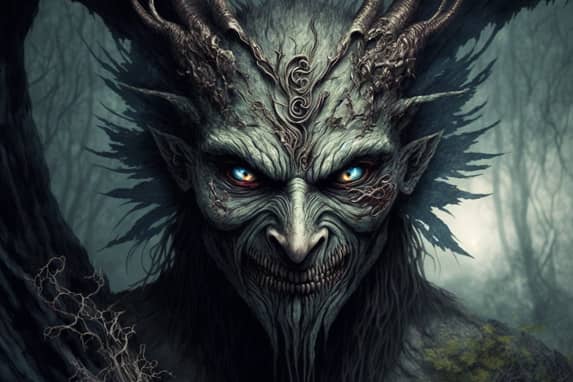The Myth of the Aswang: From Mid-East Folklore to Universal Horror
Have you ever wondered what creatures lurk in the shadows? Have you ever heard of the mythological beast known as the Aswang? This blog post will explore the mysterious origins of the Aswang, from its roots in Middle Eastern folklore to its current status as a universal horror icon. Keep reading to learn more about this dark creature and its impact on modern culture.

Origins of the Aswang
The Aswang is a fearsome, mythological creature from Southeast Asia and the Philippines. Originating in mid-east folklore, the aswang has been adapted to various cultures around the world, becoming a universal horror figure. In its original form, the aswang was an demon that consumed human flesh and blood. Today, incarnations of the aswang can take many different forms, ranging from supernatural creatures to terrifying myths. While there is no one definitive explanation for how or why the aswang first came about, it has become one of history’s most feared monsters.
The Aswang in Popular Culture
The Aswang is a creature that has been seen in various forms throughout the world for centuries. Originating from the mid-east, the aswang is said to be a demon that preys on human flesh. In some cases, the aswang is said to be a beautiful woman that transforms into a monstrous creature after mating with a human. The aswang has also been used in horror movies and television shows to create fear and suspense.
The Aswang in Philippine Folklore
The aswang is a creature that is said to inhabit parts of Southeast Asia and the Pacific Islands. The aswang is a demonic creature that typically has the head and body of a human, but the wings and talons of an eagle or vulture. The aswang is said to be a bloodthirsty monster that preys on humans.
The aswang is often depicted as a hideous creature with razor-sharp claws and teeth. The aswang is also said to have the ability to fly, and it is often depicted flying through the air after its prey. The aswang is said to be able to transform into any animal, and it is often depicted as a demon-like creature with horns or spikes on its head.
The aswang is said to be a fearsome monster that can easily kill a human. The aswang is often used in horror movies and stories to create fear in the audience. The aswang is also used in traditional Philippine folklore to explain supernatural events.

The Aswang in Asian Folklore
Asian legends of vampires, werewolves and other monsters are legion. But few can match the terror caused by an aswang, a creature that is said to lurk in dark corners or wait in ambush for its prey. The aswang is often described as a horrific cross between a man and a demon-like beast with bat wings and razor sharp claws.
The aswang’s origins are uncertain but some believe it originated in Central Asia and has been spread throughout the world by traders and travelers. Aswang tales tend to focus on fear and retribution, with victims often being dragged into hell or killed outright. Interestingly, the aswang seems to have found particular popularity in Southeast Asia where it is frequently featured in folktales and vampire films.

The Aswang in Western Folklore
Origins of the Aswang Myth
The aswang is a creature that has been conjured up from Asian folklore, but also has a long history in the Western world. The aswang is typically described as a monstrous, ferocious creature with razor sharp claws and teeth, who can transform into any animal or human. In Asian folklore, the aswang is considered to be a kind of magical being that lives in dark forests and often preys on humans. In Western culture, the aswan derives its name from an unrelated species of vampiric ape called the A**laki which was first mentioned by Marco Polo in 1298 CE.
The earliest references to the aswang appear in Arabic texts from medieval Spain. These accounts describe how Zamorano de Ojeda, a Spanish explorer, was attacked by an aswang while travelling through the Philippines in the 16th century. The aswang is also mentioned in the 15th century CE Persian text, The Book of Travels of Ibn Battuta. In both Asian and Western folklore, the aswang is often associated with dark forests and nightmarish creatures.
The aswang has also been featured in a number of horror movies and TV shows, including The Exorcist (1973), The Texas Chain Saw Massacre (1974), The Shining (1980), and The Haunting (1963). In recent years, the aswang has become a popular subject for horror comics and video games.
Spread of the Aswang Legend
The Aswang legend has a long and varied history, but it is perhaps best known today as a harbinger of terror in Asian and Western culture. The aswang (literally “devil dog”) is a monstrous creature that typically inhabits dark forests or jungles, preying upon humans. Across Asia, tales of the aswang have been passed down for centuries, often serving as cautionary tales warning against the dangers of living in dangerous areas or visiting taboo places.
Despite its scary reputation, the aswang has also found popularity in horror movies and television shows. In particular, the character portrayed by Malaysian actor Anuar Azman in the 1998 movie The Blair Witch Project became an iconic representation of the legend worldwide.
The aswang legend has also spread to other parts of the world, where it has been adapted and repurposed for different purposes. In Europe, the aswang is often used to depict the fears of dark forests and witchcraft. In North America, the story of The Wolf Man is often seen as an allegory for the fear of being attacked by a wild animal.
While the aswang legend remains largely unchanged across cultures, its Meanings continue to be interpreted in various ways, serving as a warning about the dangers of trespassing into dark places or getting lost in unfamiliar territory.
Aswang in Popular Culture
The Aswang is a mythical creature of Malaysian and Indonesian folklore with origins in the Middle East. It is said to be a demon-like creature that can shift between human and beast form, and often preys on young women by attacking them in their sleep. The aswang has often found its way into popular culture, appearing in everything from horror movies to video games.
The Fear of the Unknown
The Aswang is a mythical creature from Southeast Asia that has made its way into popular culture in the West. The aswang is a fearsome creature with razor-sharp claws and teeth, and is said to be able to transform into a human or other animal. The aswang is often seen as a harbinger of death, and is feared by many for its ability to inflict harm on humans. The aswang has also been used in horror movies and books to create a sense of fear in the audience.

The Aswang in Filipino Mythology
Origins of the Aswang in Mid-East Folklore
The Aswang is a monster found throughout the Philippines. Originating in mid-east folklore, the aswang was once a benevolent creature that helped humans. However, over time, the aswang became a feared figure that threatenedhuman lives and preyed on children. Today, the aswang remains an iconic fear figure in Filipino mythology.
Elements and Characteristics of Aswangs
The aswang is a fearsome creature in Filipino folklore. They are often described as monstrous, hairy, and snake-like creatures with razor sharp claws and teeth. They are said to haunt lonely places and are known to eat human flesh.
The aswang is thought to have originated in the Middle East. It is believed that they were once human beings who went astray and became corrupted by the devil. Aswangs are said to be particularly dangerous because they can transform into any animal or monster they please. They are also known to have magical powers that allow them to curse and kill people.
There are many different stories about how the aswang came to be. Some say that they were once human beings who became corrupted by the devil. Others say that they are the spirits of dead people who have been cursed by the gods. Still others believe that aswangs are actually monsters who have evolved from different animals.
There is no one story about the aswang that is correct. They are a popular figure in Filipino folklore and there are many different versions of their story. However, most agree on one thing: aswangs are dangerous, monstrous creatures who should be avoided at all costs!
Cultural Diffusion: The Globalization and Popularization of the Aswang Mythology
In Philippine mythology, the aswang is a creature that most often takes the form of a humanoid being with wolf-like features. The aswang is feared by many Filipinos and is seen as an omen of ill luck or death. The aswang has also been introduced to other cultures around the world and has become one of the most popular horror villains in entertainment media.
There is no singular origin story for the aswang legend, which likely stems from various influences brought over by waves of immigrants who have populated the Philippines over time. Most versions of the story describe how a wicked witch cursed an innocent man named Asuan with transforming into an aswang upon death. Due to fear and superstition surrounding this creature, Asuan is often depicted as a bloodthirsty monster who preys on human flesh.
The aswang has also been popularized in various forms of popular culture. Films and television shows featuring the aswang as a central villain have become increasingly popular in recent years. This includes adaptations of Filipino horror novels and manga, as well as American and Japanese horror movies.
The popularity of the aswang legend is likely due to its universal themes of fear and horror. While the specific details of the story may vary from culture to culture, the underlying fear of the unknown is common to all versions of the legend.
Transforming Fear into Inspiration: The Legacy and Influence of the Aswang
Since ancient times, the Aswang has terrorized Filipinos with its bloodthirsty and cruel behavior. The aswang is a hybrid creature that is half human and half beast, usually depicted as a hideous winged creature with razor-sharp teeth. These creatures are said to originate from East Asia and were first brought to the Philippines by Admiral Zheng He in the 15th century.
The aswang was primarily feared because of its savage nature and propensity for attacking humans. However, over time, the aswang has also been revered for its ability to inspire fear into others. This is evident in many Philippine legends and folklore, where the aswang is often used as a metaphor for overcoming fear and adversity. In some cases, such as in The Aswang of Iloilo, the aswang is used to teach children about the importance of bravery.
The aswang has also had a significant impact on Filipino culture and art. The popularity of horror films and literature in the Philippines has helped perpetuate the legend of the aswang and encouraged further exploration into its lore. Additionally, popular artistworks such as sculptures and paintings have often been inspired by the aswang mythological creature.

The Aswang in the Modern World
The Aswang has always been a popular figure in the folklore of many cultures, but has recently become a popular horror icon in the modern world. This is likely due to the success of the film The Exorcist, which featured an Aswang as one of its main antagonists.
Despite its popularity, the Aswang is not a well-known figure in mainstream culture. This may be due to its negative reputation, which is based on myths and legends that are often exaggerated or inaccurate. Nevertheless, the Aswang remains an important part of the folklore of many cultures, and is likely to continue to be popular in the future.
Conclusion
The aswang is a creature that has been known throughout the world for centuries. It is said to be a demon that preys on humans, and is often portrayed as a monster with razor-sharp claws and teeth. In the modern world, the aswang is often seen as a symbol of horror and terror. However, this creature has a long and varied history, and can be found in many different cultures around the world.
The Aswang is a complex and multifaceted creature, with its origins in the mid-east and its presence felt throughout multiple cultures around the globe. It has been adapted to fit various interpretations within different regions, making it an iconic figure used in horror stories and popular culture alike. No matter how one may view them, however, the Aswang remains a powerful symbol of fear that continues to capture imaginations today.

Shoptimizer Blog
Meditation williamsburg kogi blog bushwick pitchfork polaroid austin dreamcatcher narwhal taxidermy tofu gentrify aesthetic.
Humblebrag ramps knausgaard celiac, trust fund mustache. Ennui man braid lyft synth direct trade.


